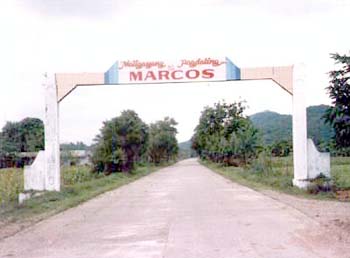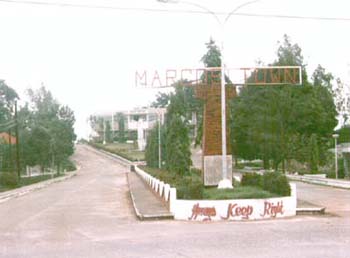

| Municipality of MARCOS |

The Municipality of Marcos came into being by virtue of Republic Act. No. 3755 authored by then Congressman Simeon M. Valdez, former Congressman of 2nd District of Ilocos Norte. Said Republic Act was finally approved January 28, 1963 but Marcos was formally separated from her mother municipality, the town of Dingras on September 11, 1963 which date coincided with the birthday of President Ferdinand E. Marcos. The town has 6 original barangay. These barrios were sub-divided thereby increasing its barangays into 13 all named after Pres. Ferdinand Marcos ' clan. Its land area is approximately 17,008 hectares. It is bounded on the north by her mother town, Dingras; on the west by the municipalities of Batac and Sarrat; on the east by Mountain Province traversing the municipality of Nueva Era. It is approximately 28 kilometers from Laoag City. The barangay road network is 124 kilometers and municipal streets is 4.57 kilometers. The town is traversed by tributaries of the Papa River, Burna River and Padsan River. The health service is bolstered with the presence of the Northern Ilocos Norte District Hospital.
The young town is undertaking a surprisingly good number of infrastructure projects like the construction of bridges, schools, buildings, dams and irrigation system, for the welfare of the people the project of Hon. Tabucbuc worth mentioning are the construction of the monument of Don Mariano Marcos in front of the municipal hall, the lands-caping and beautification done in front of the municipal hall and the building of the Marcos Maternity Hospital. In general, the people are poor. Most of them depend on farming to meet their needs, while a few Hawayanos, pensionados and professionals live more prosperously. Fishing is not done, because of the absence of fishing grounds. The farmers are owner cultivators, leases and tenants. Majority of them practice modern ways of rice culture, such as planting high yielding varieties. This is attributed to the presence of technicians helping the town, especially in the organization of Samahang Nayon in each barangay. Minor industries include hunting and lumbering. The people make use of their leisure time by going to the forest nearby to hunt are gather firewood for home consumption or for sale in local markets. |






